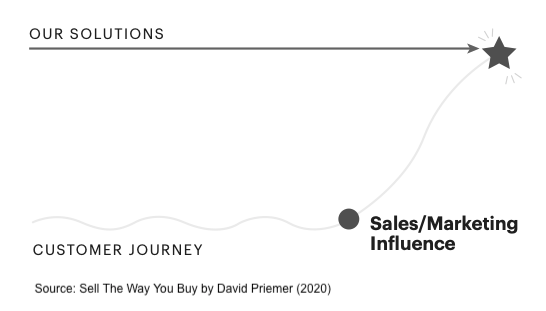3 Powerful Ways to Lead Your Customer Through the Buying Process
In part one of this post, I shared research on how modern sales and marketing organizations can drive revenue growth by being more prescriptive in their selling motions. In other words, by leading their customers through the buying process and reducing distractions and choice, they can make it easier for their customers to buy and reduce feelings of post-purchase regret. In this post, I’ll share three tactical examples of how you can inject a more prescriptive approach into your sales operation.
Before we jump in it’s important to note that executing with the power of prescription doesn’t negate the all-important discovery behaviors of asking good questions and listening! Nor does it means flagrantly overriding the feedback signals you’re getting from your customers and charging ahead. It means being mindful of simple but powerful ways you can shape your customer’s journey, needs, and requirements so that they intersect with your solution.

Here are three examples.
1. Problem Definition
Customers often have nagging and hidden problems they haven’t fully come to terms with. While they might experience the impact of these problems every day (and as sellers, we know they have them), their lack of awareness means they’ve rarely crystallized those problems into thoughts and words. In Sell The Way You Buy, I refer to these as Unknown-Unspoken problems. This means that, as the seller, you have the unique opportunity to label and define these problems, bring them to your customers, and by doing so, take a leadership position in solving them!
For example, consider a busy small business owner wearing more hats than she should. She builds and sells her product, invoices the customers, maintains the website, creates the marketing content, and handles all of the support questions. She shoulders this tremendous daily burden blissfully unaware that many of these functions can be efficiently and professionally outsourced. That is until you approach her and say, “I work with busy entrepreneurs like you who feel they need to own all the jobs in their business but secretly suspect that the low-value tasks they’re spending their precious time on are stifling their growth! I have a solution to help.” Are you reading my mind?!? Where have you been for the last five years?
Question: what Unknown-Unspoken problems might your ideal customers be experiencing?
Bonus video: How to Build Massive Sales Credibility by Unleashing their Unknown-Unspoken problems
2. Evaluation Criteria
On a recent podcast appearance, the host told me that after 30 years of faithful service, his water heater conked-out and he found himself in the market for a new one. His initial thought was to replace it with a newer version of the old unit. After all, water is water, right? Wrong! Little did he realize how much water heating technology has changed over that time and after a brief education by a local contractor, he ended up going with a modern, tankless hot water system. As is often the case when it comes to new and innovative products and services, don’t assume that customers know how to best match their problems to the solutions you provide.
For example, back at my third startup, we provided a modern coaching and recognition platform for companies who loved feedback but hated performance reviews. While innovative and forward-thinking companies quickly took to the concept, they didn’t quite known how to figure out if our solution was right for them. I remember one customer who told us she loved the idea, but when she asked her team for a list of solution requirements, it read like the manual for an old-school performance review solution. If we assumed a reactive stance and simply responded to the client’s stated requirements, there’s no way we would have won the business. So rather than allowing the client to drive the evaluation in the wrong direction, we decided to adopt a high-conviction, prescriptive approach.
We came back to the client with a revised list of features and use-cases we believed they needed to evaluate in order to solve their problem. From there we highlighted stories of our progressive customers like Facebook and Pixar, and how they were addressing the same challenges with our solution. The customer recognized our authentic desire to modernize their evaluation process and lead them through the evaluation. Not only did we end up winning the business, but that customer went on to become one of our biggest advocates.
Question: how might you reframe the way your ideal customers evaluate your solution?
3. Next Steps
The best salespeople know that setting high-value next steps at the end of your customer conversations is critical to moving a deal along. In fact, data from the team at Gong shows that close rates decline by 71% when reps forget to cover next steps on the first call. But not all next steps are created equal!
For example, at the end of a discovery call if you asked your customer “So what would you like to do as a next step?” they might say, “Can you email me some more information and pricing and I’ll get back to you?” Or if your company offers a free trial, the customer might say, “We’d like to play around with the free trial for a bit and see how it goes.” Complying with these types of requests will often put your sales cycle on the slow road to failure (and the only thing worse than losing, is losing slowly).
Instead, use the power of prescription to supercharge the impact of your next steps by doing three things:
- Assemble your toolbox of options: don’t get caught flat-footed! Curate a list of possible next steps that can move your deal forward in a meaningful way. Perhaps it’s a secondary discovery call with key stakeholders, having the customer provide you with some information to allow you to do a follow-up analysis, or directing them to a page on your website to conduct a valuable self-assessment.
- Select the best one: try not to confuse your customer by providing too many options. Remember, in part one of this post we talked about how more choices can confuse buyers. A single, well-calculated next step will serve both you and your customer best here.
- Recommend, don’t force: this nuance is very important! As we’ve discussed in the past, when customers feel cornered, a psychological principle known as reactance kicks in and they become extremely defensive. Instead, soften the directive prescription by saying something like “As a next step, my clients typically like to take a self-assessment using our online tool, and then have a follow-up call to explore the results. From there we can decide together whether or not to move forward. Do you think it makes sense to do that here? ” In this case, you’re not only providing social proof by referencing how similar clients evaluate your solution (per section #2 above) but if they agree after being given the choice, they will be more committed to the next step.
Question: what next step can you recommend to your customers to move your deal along while reducing friction?
Bonus video: 3 Ways to Sell More by Leading Your Buyer
And finally, don’t be afraid to address and reframe any objections that arise during the process. For example, if a prospective customer suggests they “play around with the free trial for a bit and see how it goes“, there’s nothing wrong with saying something like, “I totally understand where you’re coming from and want to make sure you’re comfortable with the solution. Our clients tell us they get way more value out of the free trial, and save a ton of ‘clicking around’ time when we have a follow-up call to learn about their key use-cases and walk them through the trial system one-on-one. Would you be interested in something like that?”
Leading your customers through the buying process with conviction is one of the best ways to maximize your close rates while providing them with the expert help and guidance they need. To do that, the power of prescription, when used with due care and empathy, can be a powerful ally!
We promise never to send you junk or share your email! Just helpful sales insights.














Leave a Reply
Want to join the discussion?Feel free to contribute!